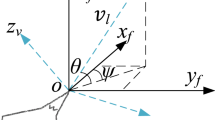Abstract
This paper presents an efficient and feasible algorithm for the path planning problem of the multiple unmanned aerial vehicles (multi-UAVs) formation in a known and realistic environment. The artificial potential field method updated by the additional control force is used for establishing two models for the single UAV, which are the particle dynamic model and the path planning optimization model. The additional control force can be calculated by using the optimal control method. Furthermore, the multi-UAV path planning model is established by introducing “virtual velocity rigid body” and “virtual target point”. Then, the motion states of the lead plane and wingmen are obtained from the path planning model. Finally, the path following process based on the quadrotor helicopter PID controllers is introduced to verify the rationality of the path planning results. The simulation results show that the artificial potential method with the additional control force improved by the optimal control method has a good path planning ability for the single UAV and the all UAVs formation. At the same time, the path planning results are available and the UAVs can basically track the UAV formation.
Similar content being viewed by others
References
Garcia, M., Viguria, A., Ollero, A.: Dynamic Graph-Search Algorithm for Global Path Planning in Presence of Hazardous Weather (2012)
Khatib, O.: Real-time Obstacle Avoidance for Manipulators and Mobile Robots. Int. J. Robot. Res. 5 (1), 90–98 (1986)
Dunbar, W.B., Caveney, D.S.: Distributed Receding Horizon Control of Vehicle Platoons: Stability and String Stability. IEEE Trans. Autom. Control 57 (3), 620–633 (2012). doi:10.1109/TAC.2011.2159651
Pei, L., HaiBin, D.: Path Planning of Unmanned Aerial Vehicle Based on Improved Gravitational Search Algorithm. Sci. China Technol. Sci. 55 (10), 2712–2719 (2012). doi:10.1007/s11431-012-4890-x
Roberge, V., Tarbouchi, M., Labonte, G.: Comparison of Parallel Genetic Algorithm and Particle Swarm Optimization for Real-time UAV Path Planning. IEEE Trans. Ind. Inform. 9 (1), 132–141 (2013). doi:10.1109/TII.2012.2198665
Anderson, B.D.O., Yu, C., Baris, F.: Information Architecture and Control Design for Rigid Formations. In: 26th Chinese Control Conference, 26-31 July 2007, Piscataway, NJ, USA 2007. Proceedings of the 26th Chinese Control Conference. IEEE (2007)
Xiaohua, W., Yadav, V., Balakrishnan, S.N.: Cooperative UAV Formation Flying with Obstacle/Collision Avoidance. IEEE Trans. Control Syst. Technol. 15 (4), 672–679 (2007). doi:10.1109/TCST.2007.899191
Das, A.K., Fierro, R., Kumar, V., Ostrowski, J.P., Spletzer, J., Taylor, C.J.: A Vision-based Formation Control Framework. IEEE Trans. Robot. Autom. 18 (5), 813–825 (2002). doi:10.1109/TRA.2002.803463
Chang Boon, L.: A Dynamic Virtual Structure Formation Control for Fixed-wing UAVs. In: 2011 9th IEEE International Conference on Control and Automation (ICCA 2011), 19-21 Dec. 2011, Piscataway, NJ, USA. IEEE (2011)
McInnes, C.R.: Velocity Field Path-planning for Single and Multiple Unmanned Aerial Vehicles. Aeronaut. J. 107 (1073), 419–426 (2003)
Bemporad, A., Rocchi, C.: Decentralized Linear Time-varying Model Predictive Control of a Formation of Unmanned Aerial Vehicles. In: 2011 50th IEEE Conference on Decision and Control and European Control Conference (CDC-ECC 2011), 12-15 Dec. 2011, Piscataway, NJ, USA, 7488–7493 (2011). IEEE
Chen Y.-b., Luo G.-c., Mei Y.-s., Yu J.-q., Su X.-l.: UAV path planning using artificial potential field method updated by optimal control theory. Int. J. Syst. Sci. (2014). doi:10.1080/00207721.2014.929191
Cetin, O., Zagli, I., Yilmaz, G.: Establishing Obstacle and Collision Free Communication Relay for UAVs with Artificial Potential Fields. J. Intell. Robot. Syst. 69 (1-4), 361–372 (2013)
Charifa, S., Bikdash, M.: Comparison of geometrical, kinematic, and dynamic performance of several potential field methods. In: IEEE SoutheastCon 2009, 5-8 March 2009, Piscataway, NJ, USA. IEEE (2009)
Luo, G.-c., Yu, J.-q., Zhang, S.-y., Zhang, W.: Artificial Potential Field based Receding Horizon Control for path planning. In: 2012 24th Chinese Control and Decision Conference (CCDC), 23-25 May 2012, Piscataway, NJ, USA. IEEE (2012)
Zhang, X., Duan, H., Yu, Y.: Receding Horizon Control for Multi-UAVs Close Formation Control Based on Differential Evolution. Sci. China Ser. F (Inf. Sci.) 53 (2), 223–235 (2010). doi:10.1007/s11432-010-0036-6
Yanyang, W., Tietao, W., Xiangju, Q.: Study of Multi-objective Fuzzy Optimization for Path Planning. Chin. J. Aeronaut. 25 (1), 51–56 (2012). doi:10.1016/S1000-9361(11)60361-0
Hua, S., You, Y., Zhang, H., Song, H.: Receding Horizon Control of UAV Formations. Electron. Opt. Control. 19 (3), 1–5 (2012)
Wu, S.: Optimal Control Theory and Application. China Machine Press, Beijing (2008)
Xie, L.-j., Xie, G.-r., Chen, H.-w., Li, X.-l.: Solution to Reinforcement Learning Problems with Artificial Potential Field. J. Cent. South Univ. Technol. 15 (4), 552–557 (2008). doi:10.1007/s11771-008-0104-
Mohamed, H.A., Yang, S., Moghavvemi, M.: Sliding Mode Controller Design for a Flying Quadrotor with Simplified Action Planner. In: ICCAS-SICE, 2009. IEEE (2009)
Bouabdallah, S., Siegwart, R.: Full Control of a Quadrotor. In: 2007 IEEE/RSJ International Conference on Intelligent Robots and Systems, 29 Oct.-2 Nov. 2007, Piscataway, NJ, USA 2007. IEEE (2007)
Bai, Y., Liu, H., Shi, Z., Zhong, Y.: Robust Flight Control of Quadrotor Unmanned Air Vehicles. Jiqiren/Robot 34 (5), 519–524 (2012). doi:10.3724/SP.J.1218.2012.00519
Salih, A.L., Moghavvemi, M., Mohamed, H.A., Gaeid, K.S.: Modelling and PID Controller Design for a Quadrotor Unmanned air Vehicle. In: Automation Quality and Testing Robotics (AQTR), 2010 IEEE International Conference on. IEEE (2010)
Efe, M.Ö.: Neural Network Assisted Computationally Simple PID Control of a Quadrotor UAV. IEEE Trans. Ind. Informat. 7 (2), 354–361 (2011)
Koren, Y., Borenstein, J.: Potential Field Methods and their Inherent Limitations for Mobile robot navigation. In: Robotics and Automation, 1991. Proceedings., 1991 IEEE International Conference on. IEEE (1991)
Author information
Authors and Affiliations
Corresponding author
Rights and permissions
About this article
Cite this article
Chen, Y., Yu, J., Su, X. et al. Path Planning for Multi-UAV Formation. J Intell Robot Syst 77, 229–246 (2015). https://doi.org/10.1007/s10846-014-0077-y
Received:
Accepted:
Published:
Issue Date:
DOI: https://doi.org/10.1007/s10846-014-0077-y




